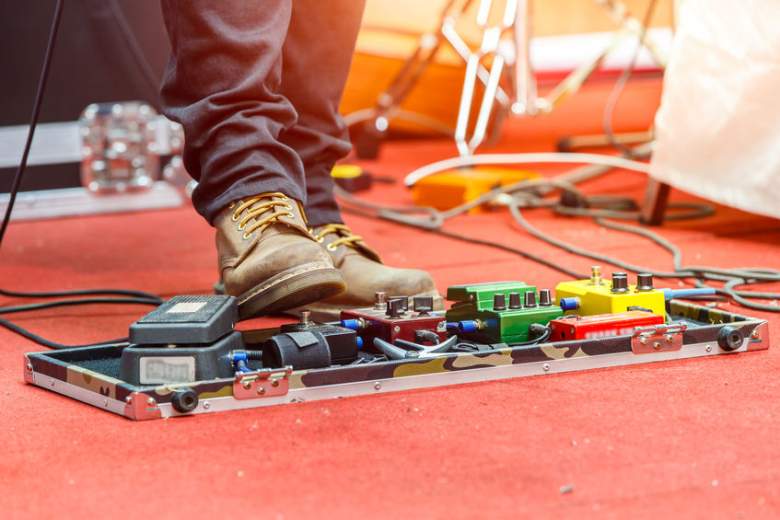
In our reverb-delay combo pedals post, I discussed that the two effects make a natural pairing, practically begging to be combined into one pedal. They typically appear at roughly the same spot in the signal chain, and do somewhat similar jobs. They’re equally at home on monster pedalboards and stripped down fly rigs.
In our post on the best boost pedals, I talked about how boost and overdrive are mighty similar, as well. They can both affect serious magic in a tube amp, generating natural compression that feels great under the hands. Of course there are differences between them, and most players would have (at least) one of each.
As the popularity of combo pedals continues to grow, we’re starting to see some excellent examples of boost-overdrive combo pedals hit the market. For a lot of players, pairing one of these with a combo reverb-delay could very well be their entire pedalboard. For the more adventurous out there, they provide an inherently useful, relatively utilitarian platform on which to build. For those looking for flexible all-in-one drive units, below find the best boost overdrive combo pedals.
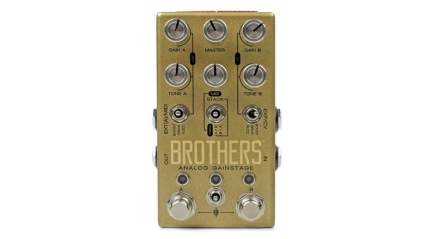
|
Amazon Customer Reviews
|
Price: $383.90 Shop at Amazon | Shop now Read our review |

|
Amazon Customer Reviews
|
Price: $361.05 Shop at Amazon | Shop now Read our review |
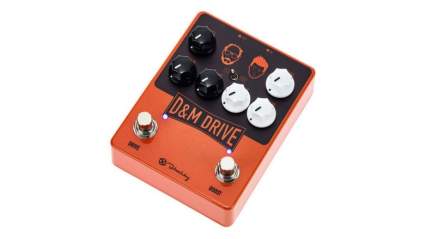
|
Amazon Customer Reviews
|
Price: $229.00 Shop at Amazon | Shop now Read our review |
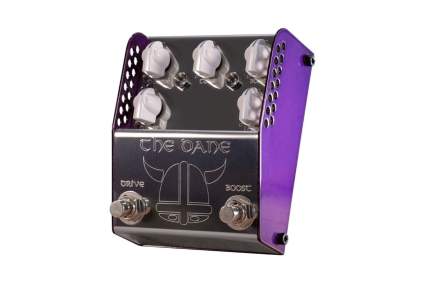
|
Amazon Customer Reviews
|
Price: $319.00 Shop at Amazon | Shop now Read our review |
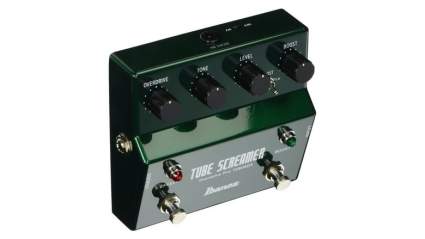
|
Amazon Customer Reviews
|
Price: $460.00 Shop at Amazon | Shop now Read our review |
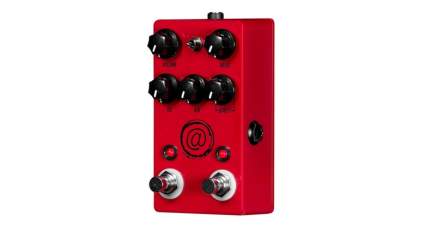
|
Amazon Customer Reviews
|
Price: $219.00 Shop at Amazon | Shop now Read our review |
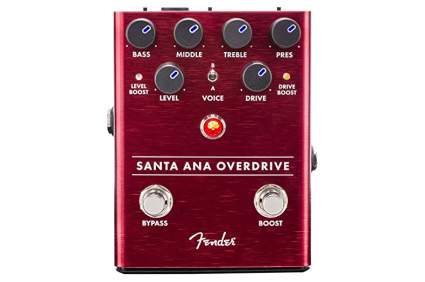
|
Amazon Customer Reviews
|
Price: $184.51 Shop at Amazon | Shop now Read our review |

|
Amazon Customer Reviews
|
Price: $249.99 Shop at Amazon | Shop now Read our review |
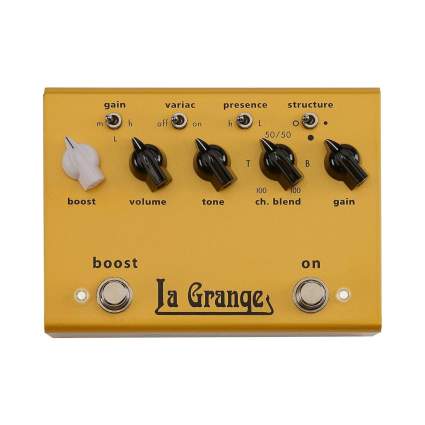
|
Amazon Customer Reviews
|
Price: $249.99 Shop at Amazon | Shop now Read our review |

|
Amazon Customer Reviews
|
Price: $235.17 Shop at Amazon | Shop now Read our review |
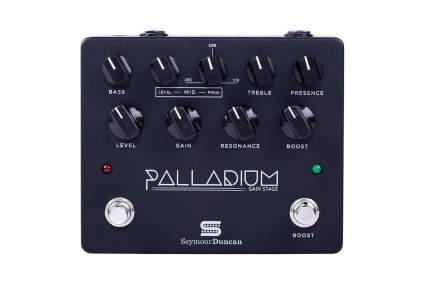
|
Amazon Customer Reviews
|
Price: $388.70 Shop at Amazon | Shop now Read our review |
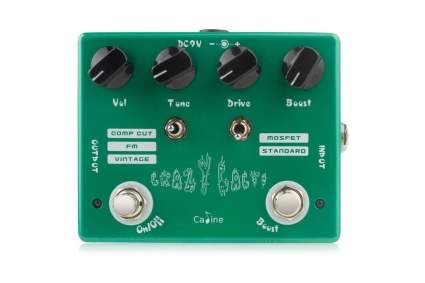
|
Amazon Customer Reviews
|
Price: $37.95 Shop at Amazon | Shop now Read our review |
-
1. Chase Bliss Audio Brothers Analog Gainstage
Pros:- 33 combinations of boost, overdrive, and fuzz
- Advanced MIDI options
- Preset capabilities
Cons:- Expensive
- Takes sometime to get to know it
- Probably overkill for a lot of situations
This beast of a machine from Chase Bliss meets and exceeds the requirements for appearing on our list, featuring the requisite boost and overdrive, but also a fuzz circuit. Each of these are assignable to either of the two channels in the pedal, and there are 33 routing combinations thereof, making it extremely flexible.
Controls on this unit include a Master volume and a Mix knob, as well as a Gain and Tone for each channel. A switch below the knobs lets you easily select between the boost, drive, or fuzz circuit. The Stack switch allows you to change the routing, with options for Parallel, A into B, and B into A, tunable with the Mix knob. This would be eminently usable if that were all, but since it’s Chase Bliss, there’s more going on here.
The toggle between the footswitches recalls two presets. Preset #1 is to the right, which you can assign by holding down the right footswitch for three seconds, then holding down both footswitches for an additional three seconds until the LED blinks confirming a save. Preset #2 is to the left and assignable by the same process, except starting with the left footswitch. You can use MIDI to recall your presets, or use the company’s own Faves pedal to do that job. Every setting on the pedal can be saved this way, including the position of the dip switches.
According to the user manual, the dip switches work with your expression of choice in the following manner: “The Master, M/S, Gain A, Tone A, Gain B, and Tone B dip switches on the left side simply turn that parameter on or off expression / CV capability. Master, M/S, Gain A, Tone A, Gain B, and Tone B dip switches on the right side control whether or not the parameters will rise (go clockwise with expression) or fall (go counterclockwise with expression).”
All of this is digitally controlled, but each of the circuits are totally analog; this isn’t a DSP situation. Incredibly modern, incredibly flexible pedal that could just be your be-all, end-all.
The Pete Thorn walkthrough should provide all the tones and intro you need.
It’s possible to save as much as $100 when shopping for this pedal used on Reverb.
Specs:
- Clipping circuitry: JFET, IC
- Voicing: Custom
- True bypass?: Yes
- Switchable order?: Yes
- Power: 60 mA at 9V DC
- Other features: Expression pedal input with dip switches to customize, preset save, MIDI input for recalling presets, optional buffer
Find more Chase Bliss Audio Brothers information and reviews here.
-
2. EarthQuaker Devices Palisades Mega Ulitmate Overdrive
Pros:- Extremely flexible clipping options
- Flexi-Switching for both latching and momentary use
- Bandwidth knob sets gain range
Cons:- Could be somewhat overwhelming
- Can't swap boost and OD order
- Pricey
After long resisting calls to do so, EQD finally came out with their take on the vintage TS808. Uninspired by the original, though, they went above and beyond to make the old workhorse into something new. Somewhere in this pedal is every kind of Tube Screamer sound, so spend some time tweaking and you’ll have them all in one place.
For knobs, you get Boost, Volume, and Tone, as well as Gain A and Gain B. You also get a Voice knob that lets you choose from six different clipping voices, as well as a Bandwidth knob that sets the range of tone and gain available to those respective knobs.
The settings for the Voice knob are as follows: 1. No diodes: Least distortion, most open. 2. LED clipping: A small amount of breakup with lots of volume. 3. Mosfet clipping: Sparkly overdrive good for harmonics. 4. Asymmetrical Silicon clipping: Closest to the original 808 sound. 5. Symmetrical silicon clipping: Tight and distorted. 6. Schottky Diode clipping: More akin to fuzz.
This is huge for experimentation, but also for dialing in the right sound for your exact setup. The Boost footswitch is, of course, set by the Boost knob and gives you additional volume when you need it. You select between the two Gains using the Gain B switch, and the Activate switch is a true-bypass on-off. Gain A is lower in gain an better for chords, while Gain B is heavier and excellent for shredding. You also get a Bright/Normal switch and a Buffer switch that can tighten up tone.
If all that weren’t enough, this pedal also has what EQD call “Flexi-Switching”. This means that the Gain B and Boost switches can be used normally as latching switches, but if you hold them, they turn into momentary switches. That’s especially well-suited to the boost, but driving the amp harder for short sections is an interesting use, too.
Sure, it’s a bit of a pedalboard hog, but it’s also among the most supremely flexible overdrives on the market. If that’s an issue, this general idea also comes in non-boost-enabled format, called Dunes.
Wath the extensive Mike Hermans demo to hear it and learn more.
Used availability is good on Reverb and can save you a significant chunk from the new price.
Specs:
- Clipping circuitry: LED, Mosfet, Silicon, Schottky IC
- Voicing: Tube Screamer TS808 (and beyond)
- True bypass?: Yes
- Switchable order?: No, fixed as post-gain boost
- Power: 45 mA at 9V DC
- Other features: Bandwidth and Voice selectors, Flexi-Switching for latching and momentary use
Find more EarthQuaker Devices Palisades information and reviews here.
-
3. Keeley D&M Drive Overdrive & Boost
Pros:- Sides can be separated using TRS cables
- Switchable boost and OD order
- Usable all along the gain range
Cons:- Advanced switching useless without a competent switching system
- Control set somewhat limited compared to other options
- Expensive
Fans of the best show on the internet, That Pedal Show will already be totally familiar with this pick. Since it was Mick’s comment that inspired my reverb-delay combo pedals post, I would be remiss if I missed this one here.
Created by Robert Keeley to reflect the dual personalities of the show, this pedal is definitely for Strat and/or Tele swinging players with the finest in boutique tube amps (running wet/dry, of course) behind them. But it’s also for the rest of us, too.
This is a pretty straightforward affair with Level, Gain, and Tone knobs for each side. They’re independently switchable, with a toggle switch to decide the order. They’re so independent, in fact, that clever use of TRS cables will allow you to send each to different parts of a signal switcher, like Dan’s GigRig G2, to choose just any random example.
The Dan side is a full-range, multiple-gainstage overdrive that ventures into distortion territory. It’s saturated and full of harmonics. The Mick side is higher-headroom with a pronounced mid-boost, not unlike a Tube Screamer. These guys have played their fair share of pedals, so if this is what they came up with when they worked with Keeley, it’s almost certainly worth a look.
Check out Rabea Massaad’s lengthy demo for sounds and uses.
It’s not uncommon to find used units on Reverb for under $200.
Specs:
- Clipping circuitry: Unknown, but the Mick side is a take on the Tube Screamer circuit and the Dan side is likely a modified Katana
- Voicing: Custom
- True bypass?: Yes
- Switchable order?: Yes
- Power: 55 mA at 9V DC
- Other features: TRS insert cables for independent integration into switching systems
-
4. ThorpyFX The Dane Boost Drive
Pros:- Unmatched build quality
- Very versatile
- Designed for articulation and dynamics
Cons:- Crazy expensive
- Can't swap boost and OD order
- Knob labels are very difficult to read
Fans of Danish Pete Honore and/or responsive overdrives will want to consider this device, which is his signature pedal and one of Thorpy’s best creations. It’s incredibly touch sensitive, with a boost that manages to add headroom as opposed to just pushing an amp into compression.
On the Drive side, you get Volume, Tone, and Drive. Pretty straightforward, but with wide ranges on all of them. Memorize which is which, though, because in virtually any lighting situation, the labels are difficult to read.
On the Boost side, there is Boost level and Lows. The Lows control might be especially useful for pickup matching between different guitars, say switching from humbuckers to single coils. This boost is fixed pre-drive, but the two can be used independently when you need that.
You could also consider the boost/fuzz combo The Veteran, too.
For sound samples, watch either the Rabea Massaad demo or see the man himself talk about it.
The price, though. ThorpyFX only uses the highest quality parts on the market, with a price to match the care that goes into it. You may want to look for a used one on Reverb to save yourself a little money.
Specs:
- Clipping circuitry: Unknown
- Voicing: Custom
- True bypass?: Yes
- Switchable order?: No, fixed as pre-gain boost
- Power: 34 mA at 9V DC
- Other features: Virtual indestructibility
-
5. Ibanez TS808DX Tube Screamer Booster/Overdrive Pedal
Pros:- Switchable boost and OD order
- Can be run at 18v for higher headroom
- Simple, straightforward operation
Cons:- Fairly costly considering ubiquity of Tube Screamers
- Limited control set
- Requires a tube amp to get the most out of it
If we’re going to include another company’s boost plus Tube Screamer offering, it only seems fair that we also include the one from Ibanez itself. This is a far simpler unit than the first two on this list, simply combining the overdrive you know and love with a +20dB boost added to it.
Controls are straightforward and utilitarian, including Overdrive (gain), Tone, Level, and Boost. It’s the control set you know and love from other Tube Screamers, with the last of these knobs controlling the level of boost activated with the Boost footswitch. There’s a Pre/Post switch so you can set it before or after the 808 gainstage.
The boost can be used independently of the drive circuit, which isn’t the case for every pedal on this list. If you know and love the Tube Screamer but want one of these combo pedals, this is probably the one for you. Much less flexible than some of the others, but much less fussy, too.
The Premier Guitar demo gives you a great primer on this reimagined classic.
These are a little rarer than some of the other options on this list, but it’s worth a peek at Reverb to see if you can grab it used and save some money.
Specs:
- Clipping circuitry: JRC4558D IC
- Voicing: Tube Screamer TS808
- True bypass?: Yes
- Switchable order?: Yes
- Power: 9V OR 18V DC
- Other features: Toggle switch for 9V or 18V operation for higher headroom
Find more Ibanez TS808DX Tube Screamer Booster/Overdrive Pedal information and reviews here.
-
6. JHS AT+ Andy Timmons Signature Overdrive Pedal
Pros:- Wattage switch allows for customized feel
- Can be run at 18v for more headroom
- Capable of very heavy tones
Cons:- Can't change boost and OD order
- Drive range may be excessive for some
- Jacks on the cheap side
So, we’ve got 60s Plexis covered, but what if you’re more of a JCM fan? The original Andy Timmons signature from JHS was a custom take on the Angry Charlie, which is meant to be a JCM800 in a (smaller) box. The latter of these we discussed briefly in our best distortion pedals post as it is/is not a clone of a MI Audio Crunch Box, depending on who you ask. Anyway, back to the topic at hand.
JHS has just recently released the AT+, which takes all that JCM goodness that was custom-voiced for Andy and adds a boost circuit to the front of it. That’s right, the front, just like the Wampler above. There’s a knob for controlling the boost level, but otherwise the control set is the same, including Volume, Drive, EQ, and Air. The Air knob is essentially a presence control for controlling top-end brightness.
The toggle switch in the middle controls the 25-, 50-, and 100-watt modes, which allows you to dial in the perfect mix of overall volume, crunch, and compression. While you can’t change the boost order, they are completely independent, so you can choose to use that boost alone or to saturate the pedal.
Like a few of the others on this list, JHS has boost plus overdrive options. You could also have a look at the Ruby Red Butch Walker Signature, which goes after 60s Supro amps, or The Kilt, which combines a JFET boost with an updated Bixonic Expandora.
Who better than the elusive Gearmandude to demo this box of rock.
Values for used units on Reverb generally come to rest comfortably under $200.
Specs:
- Clipping circuitry: Unknown
- Voicing: 80s Marshall amp
- True bypass?: Yes
- Switchable order?: No, fixed as pre-gain boost
- Power: 100 mA at 9V or 18V DC
- Other features: Three-way mode switch
Find more JHS AT+ Andy Timmons Signature Overdrive Pedal information and reviews here.
-
7. Fender Santa Ana Overdrive
Pros:- Unique look and feature set
- Switchable boost and OD order
- Optionally buffered or true bypass
Cons:- Relatively high current draw for an overdrive
- Can't use boost independently of OD
- Expensive compared to better options
When I originally reviewed the then-new line of Fender pedals, I found the whole line to be very good value, in part because of a few nifty little design touches they included. Among them was this very good overdrive/boost combo pedal, which aside from the compressor, might be one of the best in the range.
Controls include a four-band EQ across the top, Level, and Drive. The toggle in the middle controls what Fender refers to as an American and British amp voicing. In my experience, the American was a bit shrill, but there’s a wide range of usable tones to be found in the British side.
On the top of the pedal, you’ll find switches for FS Select, which allows you to change the gain order, which is indicated by the Level Boost and Drive Boost LEDs. There’s also a switch between buffered or true bypass, and to turn the LEDs inside the knob off, if you wish.
This is an overdrive at heart, and as such, the two cannot be used independently. The boost serves to modify the overdrive circuit, but I doubt that will be much of a limitation. I like this pedal and I think a lot of players will be able to find a use for it. I’m glad Fender went with something like this instead of a more standard single-use OD.
Shane of In the Blues offers a very honest review with some great examples of the sounds.
While I do like it and think it’s a worthwhile offering, the new asking price is a touch high – it’s more expensive than the D&M Drive, which is both from a smaller boutique maker and offers far more advanced routing options. I recommend searching for a used one on Reverb where they go for over $100 less.
Specs:
- Clipping circuitry: FET
- Voicing: American and British amps
- True bypass?: Yes, optional buffered
- Switchable order?: Yes
- Power: 130 mA at 9V DC
- Other features: Voicing switch
-
8. Mad Professor Twimble Overdrive
Pros:- Adds upper harmonics for enhanced richness
- Finite adjustments allow for good dynamics
- Output impedance makes it usable in front of fuzz pedals
Cons:- Dangerous territory claiming to sound like a Dumble
- Can't change boost and OD order
- Silly control names not as intuitive as they could be
Much like the Klon Centaur, invoking the name Dumble draws a mix of cheers and jeers depending on your view. The Dumble Overdrive amp usually sells for six figures, so naturally pedal makers want to try to recreate that magic in their overdrives and this is Mad Professor’s attempt at it.
This pedal is a combination of the two Simble drives the company sells separately: the Simble Overdrive and the Simble Predriver. In accordance with its name, then, this is a fixed boost into overdrive setup, with the Predrive offering just one control: Hot/Cool, which gives you up to a +10dB boost.
The Overdrive side has four controls: Level, Sensitivity, Contour, and Accent. Level is a standard output control, while Sensitivity is the gain knob. Accent changes how much of the pick attack is highlighted, which basically translates to brightness, while Contour is a tone knob.
Like the mighty Dumble itself, this is a touch-sensitive and very dynamic drive meant to highlight your playing by adding a slight, musical compression and accentuating the upper harmonics.
Check out the Mike Hermans demo for an idea of how it sounds.
A little hunting should score you a used one on Reverb for under $200.
Specs:
- Clipping circuitry: Unknown
- Voicing: Dumble amp
- True bypass?: Yes
- Switchable order?: No, fixed as a pre-gain boost
- Power: 13 mA at 9V
- Other features: Predrive works as a compressor and upper harmonic enhancer
Find more Mad Professor Twimble information and reviews here.
-
9. Bogner La Grange Overdrive Guitar Pedal
Pros:- Unique Variac switch emulates "Brown sound"
- Boost can be used independently
- Very sturdy build quality
Cons:- Can't switch boost and OD order
- Voicing isn't compatible with all amps
- Gain range isn't entirely usable
As with the Fulltone, we could’ve made different choices here. Bogner also make the Ecstacy Blue and Ecstacy Red overdrive plus boost pedals, but the La Grange just wins out for us. This pedal goes after an overdriven Plexi sound, as so very many pedals on the market try to do. This one has some unique features that set it apart from the pack, though.
Knobs on this include Boost, Volume, Tone, Gain, and Channel Blend. The last of these controls the blend of the two channels of a ’67-’69 Plexi, with T being bright and B being normal. There’s a Structure switch that allows you to set the pedal to tight and focused to the right, open and loose to the left, and somewhere in the middle in the center. Presence allows you to dial in added high-end for more brightness, while the Gain switch sets the range of the Gain knob between High, Medium, and Low.
The real kicker is the Variac switch, which is probably among the best of the “Brown sound” emulations because it’s meant to work in a similar way to how Eddie van Halen actually did it. It affects a drop in voltage, which adds compression and harmonics. The expression pedal input works with the Gain knob and takes the knob’s position as the max. Finally, the boost in this can be used independent of the drive circuit, which is handy.
Check out the Pete Thorn demo to see what it can do.
You should have no problem finding a used La Grange on Reverb to save a little bit of coin.
Specs:
- Clipping circuitry: OP-AMP, Germanium, Class A gain stages
- Voicing: 60s Plexi amp
- True bypass?: Yes
- Switchable order?: No, fixed as post-gain boost
- Power: 9V DC
- Other features: Expression input, Variac dropped voltage switch, channel blend
Find more Bogner La Grange Overdrive Guitar Pedal information and reviews here.
-
10. Wampler Plexi-Drive Deluxe V2 Guitar Effects Pedal
Pros:- Can be run at 18v for more headroom
- Very flexible EQ
- Soft click switches
Cons:- Can't change boost and OD order
- Pricey
- Some think the tone borders on fuzz
There really are a lot of Marshall Plexi pedals on the planet, but Brian Wampler is among the people most qualified to take a crack at the genre. His YouTube channel is full of videos breaking down his intimate understanding of circuits and frequency response, and all that knowledge comes together in this excellent unit.
Controls include a three-band active EQ, Gain, Volume, and Boost. All straightforward and easy to grasp, but note that those are active EQ, so they boost and cut when needed.. There are two switches for treble and bass boost, the latter of which is supposed to emulate a kicking 4×12 cab. This is the second version, which moved the jacks to the top of the pedal and move to silent, relay-based soft footswitches.
The order of the boost and drive aren’t switchable, but where in most cases builders opt for it to be a volume boost after the drive circuit, Wampler decided to dedicate as a drive saturator boost. It’s a Tube Screamer style thing, which emulates the classic pairing used over the years. Smash a TS into the front of a Plexi — it sounds great. Now you can have that in a single pedal for use with any amp.
You might also want to consider the Pinnacle Deluxe if it’s not a Plexi sound you’re after.
Listen to Wampler himself discuss the functions and provide some tones.
Every possible incarnation of the Plexi-Drive is available used on Reverb and it’s rare that they cost more than $200.
Specs:
- Clipping circuitry: Unknown
- Voicing: Plexi amp, Tube Screamer
- True bypass?: Yes
- Switchable order?: No, fixed as pre-gain boost
- Power: 22 mA at 9V DC, 34 mA at 18V DC
- Other features: Bass and treble boost
Find more Wampler Plexi-Drive Deluxe V2 Guitar Effects Pedal information and reviews here.
-
11. Seymour Duncan Palladium Gain Stage
Pros:- Specifically designed to emulate tube preamps
- Very flexible EQ
- Meant to be used as a standalone preamp
Cons:- Very expensive
- Massive current draw for a drive pedal
- Fizzy high-end
Seymour Duncan have high hopes for this pedal, as their literature says this has “an innovative architecture that captures the full-bodied depth and character previously unattainable in an effects pedal”. What that means to you is that this is meant as a full-fledged preamp, rather than just a typical overdrive pedal.
Indeed, the company very likely intends for this to be the front end to their PowerStage 170 or PowerStage 700, so if you’re looking to shrink the size of your rig overall, this may be the right choice for you. Otherwise, the marketing is probably on the hyperbolic side, particularly given the other options on this list.
Controls include a four-band EQ of Bass, Treble, Presence, and Mids wherein the frequency is adjustable. You also get Level, Gain, Resonance, and a Boost volume. The Presence knob boosts and cuts as needed, while the Resonance adjust the amount of drive in the lower frequencies. That means there are effectively three gain stages within this pedal: the overall drive, the low frequency gain, and the boost.
As this is billed as a high-gain pedal, the high-end can be a bit fizzy or harsh depending on what you run it into, so it’s a good thing that you have so much control over it. This probably works best directly into a power amp, but some driving amps may benefit from the added tone sculpting, as well.
The ProGuitarShop demo offers a great sample of sounds.
Used examples on Reverb are commonly available under $200, which is more in line with what I think the pricing should probably be.
Specs:
- Clipping circuitry: OP-AMPS and germanium diodes
- Voicing: High-gain amplifier
- True bypass?: Yes
- Switchable order?: No, fixed as a pre-gain boost
- Power: 180 mA at 9v or 18v
- Other features: Can be used as a standalone preamp into a power amp
Find more Seymour Duncan Palladium information and reviews here.
-
12. Caline CP-20 Crazy Cacti Overdrive
Pros:- Dirt cheap
- Good voicing flexibility
- Decent gain range
Cons:- Noisy
- Will not stand the test of time
- Tragically horrible graphic design
Since the rest of the pedals on this list are quite expensive, they’re generally aimed at folks who have already been through their share of independent boosts and overdrives and are looking to combine the two for a specific purpose. On the other hand, if you just want a pedal to experiment with gain stacking for the first time or just want to try something new for cheap, this is the way to go.
It’s hard to get much cheaper than this. It’s not only less expensive than all the other options on this list, it’s less expensive than basically every single-effect pedal you can think of that isn’t also made by the Chinese clone factories. There are certainly pros and cons to that, no question, but for the guitarist without much disposable income, this is a great option.
Without sugar-coating it: It’s a Full-Drive 2 V1 clone. But for much, much less.
Controls include Volume, Tone, Drive, and the Boost level. On the left, there’s a switch to choose between three voices: Comp Cut, which removes the clipping diodes from the circuit and overdrives the OP-AMP; FM, or “flat mids” which removes the Tube Screamer-like mid hump; and Vintage, an asymmetrical clipping drive sound. The other switch allows you to choose between Mosfet and Standard clipping modes. The former is a bit more focused, while the latter is more open.
What you don’t get is build quality, of course. This uses the cheapest components available and very likely won’t put up with much abuse over time. These Chinese clones are also notoriously noisy, so recording with it will be difficult at best. If you prefer, you could opt for the Joyo Maximum, which is an ever-so-slightly nicer version for just a bit more money.
Shane of In the Blues frequently reviews these types of pedals and has a great demo of this one.
You could already buy several of these for the price of anything else on this list, which might explain why finding cheaper used units on Reverb is unlikely.
Specs:
- Clipping circuitry: Mosfet diodes, JRC4558D IC
- Voicing: Tube Screamer, Fulltone Full-Drive 2 V1 clone
- True bypass?: Yes
- Switchable order?: No, fixed as a pre-gain boost
- Power: 30 mA at 9V
- Other features: Two clipping modes, three voices
Find more Caline CP-20 Crazy Cacti information and reviews here.
What is a boost overdrive combo pedal?
At their most basic, boost pedals do one of two jobs on a pedalboard: increase saturation or increase overall volume.
For example, I use an EarthQuaker Devices Arrows before any of my other dirt pedals, in particular because it's designed to add a gain stage and boost the midrange. Thus, by combining a boost with an overdrive, you always have the ability to gain stack and tone sculpt without the need for individual units.
If the boost section of your combo boost-overdrive pedal comes first, it's meant to drive saturation of the overdrive circuit that follows it. Using it this way, you can turn your soft-clipping overdrive into something bordering on distortion, which means that the single pedal gives you three drive levels within one unit.
On the other hand, if your boost-overdrive has the boost second (or if they're switchable), you can use the boost to simply make your dialed-in overdrive sound louder. The most common use of this is for solos, but it can also come in handy for matching varying pickup output levels between guitars. Like delay and reverb, pairing these two things is obvious when it comes right down to it.
Boost-Overdrive vs. Dual Channel Drive Pedals
For this list, we're focusing on effects pedals with a boost side and an overdrive side. They must be able to cascade into one another, but it isn't a requirement that the boost can be used independently, necessarily. Some other optional goodies include: order switching, expression pedal capabilities, ability to send the outputs to different places, and so on.
However, if you want to explore more options for one-pedal gain stacking, you have a number of options to consider. Our list is aimed at boost plus overdrive, but there also the following categories:
Dual Channel Drive Pedals, including: Wampler Dual Fusion, Suhr Eclipse, T-Rex Mudhoney II, Friedman BE-OD Deluxe, Empress Heavy, and the likely king of the hill, the Origin Effects Revival Drive.
Distortion with boost, including: Electro-Harmonix Metal Muff with Top Boost, ZVex Box of Rock (though you could argue the AT+ and Plexi-Drive are very close), and Fender MTG:LA, as well as OD/Distortion combos like the Truetone Jekyll & Hyde.
Overdrive and compression, including: Truetone Route 66 and Fender Compugilist.
We also didn't put the Analogman King of Tone on this list. Is it amazing? Yes, it is. Might be the last word in boost + overdrive? It might. You know where to go to get on the list to (someday, maybe, hopefully) have one made for you, but here we're focusing on things that aren't quite so difficult to come by so you can, you know, actually play it.
Similarly, but to a much lesser degree, we considered but decided to leave out the Xotic Effects AC/RC Oz Noy, since it was limited edition.
See Also: